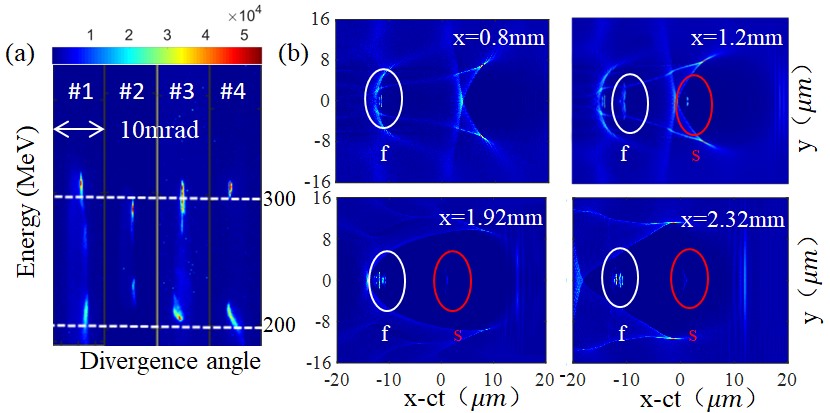Pump-probe experiments are widely used to understand the dynamics of materials on the timescale of electronic, atomic and molecular motion before damage process occurs. While nowadays the required femtosecond x-rays used as probe pulses are mostly provided by linac coherent light sources, using either slicing beamlines or free-electron lasers is restricted to a few experimental groups. Since dual-color x-rays have the quality of controllable relative delay and color separation, they are more suitable for pump-probe experiments and easier to distinguish the pump and probe pulses.
Recently, a research group from Shanghai Institute of Optics and Fine Mechanics of the Chinese Academy of Sciences (CAS) realized two-color e-beams generation in cascaded laser wakefield accelerators (LWFAs) through the combination of self-injection with density-gradient injection, and then generated dual-color γ-ray radiation with these e beams based on the self-synchronized all-optical Compton scattering scheme. The results were published on Plasmas Physics and Controlled Fusion.
In their experiments, by optimizing the laser and plasma density conditions, stable two-color e beams with energy peaks at ~300 MeV and ~210 MeV were generated firstly, as shown in Figure 1(a). To get insight into the details of two-color e-beams generation, 2D numerical simulations were performed with the PIC code. They found that the high-energy e beam was first self-injected into the second bubble and then seeded into the first bubble for reacceleration, while the low-energy beam was trapped by the first bubble through the density-gradient injection, then dephased, as shown in Figure 1(b).
Then, these two-color e beams were head-on collided with the intense laser reflected by a foil (all-optical Compton scattering scheme) to generate dual-color γ-ray radiation. The retrieved γ-ray spectrum peaked at (1.07±0.12) MeV with 38.1% FWHM energy spread, and at (0.59±0.08) MeV with 40.8% energy spread, as shown in Figure 2 (a). Using the CLARA2 program, the Compton scattering simulation of laser-electron collision was performed. Taking both the effect of laser redshifts (0.9μm) and the influence of the detected off-axis angle (1.0 mrad) into consideration, the simulated results (Figure 2(b)) were in good agreement with the experimental results and theoretical analysis.
These dual-color γ-ray sources with MeV energies are anticipated to provide practical applications in the ultrafast pump-probe nondestructive inspection, time-resolved radiology of dense materials and nuclear resonance fluorescence.
The work was supported by the National Natural Science Foundation of China, Science Foundation of Shanghai, Shanghai Sailing Program, Shanghai Strategic Priority Research Program (B).

Figure 1. (a) Energy spectra of the two-color e beams
(b) The simulated results of electron density distributions(Image by SIOM)
Figure 2. (a) The experimental retrieved spectrum
(b) The simulated energy spectra of γ-ray photons (Image by SIOM)
Related website:
https://iopscience.iop.org/article/10.1088/1361-6587/ab29d9
Contact:
Mr. Cao Yong
General Administrative Office
Shanghai Institute of Optics and Fine Mechanics, CAS
Email: caoyong@siom.ac.cn